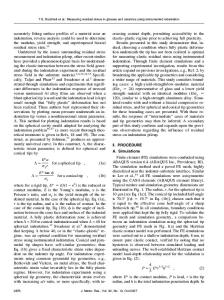Validation and Comparison of Instrumented Mouthguards for Measuring Head Kinematics and Assessing Brain Deformation in F
- PDF / 7,260,058 Bytes
- 19 Pages / 593.972 x 792 pts Page_size
- 17 Downloads / 349 Views
Annals of Biomedical Engineering (Ó 2020) https://doi.org/10.1007/s10439-020-02629-3
Concussion Biomechanics in Football
Validation and Comparison of Instrumented Mouthguards for Measuring Head Kinematics and Assessing Brain Deformation in Football Impacts YUZHE LIU ,1 AUGUST G. DOMEL,1 SEYED ABDOLMAJID YOUSEFSANI,1 JOVANA KONDIC,1,2 GERALD GRANT,3,4 MICHAEL ZEINEH,5 and DAVID B. CAMARILLO1,3,6 1 Department of Bioengineering, Stanford University, Stanford, CA 94305, USA; 2Department of Electrical Engineering, Princeton University, Princeton, NJ 08540, USA; 3Department of Neurosurgery, Stanford University, Stanford, CA 94305, USA; 4Department of Neurology, Stanford University, Stanford, CA 94305, USA; 5Department of Radiology, Stanford University, Stanford, CA 94305, USA; and 6Department of Mechanical Engineering, Stanford University, Stanford, CA 94305, USA
(Received 31 May 2020; accepted 18 September 2020) Associate Editor Stefan M. Duma oversaw the review of this article.
Abstract—Because of the rigid coupling between the upper dentition and the skull, instrumented mouthguards have been shown to be a viable way of measuring head impact kinematics for assisting in understanding the underlying biomechanics of concussions. This has led various companies and institutions to further develop instrumented mouthguards. However, their use as a research tool for understanding concussive impacts makes quantification of their accuracy critical, especially given the conflicting results from various recent studies. Here we present a study that uses a pneumatic impactor to deliver impacts characteristic to football to a Hybrid III headform, in order to validate and compare five of the most commonly used instrumented mouthguards. We found that all tested mouthguards gave accurate measurements for the peak angular acceleration, the peak angular velocity, brain injury criteria values (mean average errors < 13, 8, 13%, respectively), and the mouthguards with long enough sampling time windows are suitable for a convolutional neural network-based brain model to calculate the brain strain (mean average errors < 9%). Finally, we found that the accuracy of the measurement varies with the impact locations yet is not sensitive to the impact velocity for the most part. Keywords—Concussion, mTBI, Smart mouthguard, Electronic mouthguard, Anthropomorphic test dummy (ATD).
Address correspondence to David B. Camarillo, Department of Bioengineering, Stanford University, Stanford, CA 94305, USA. Electronic mail: [email protected] Yuzhe Liu, August G. Domel and Seyed Abdolmajid Yousefsani have equally contributed to this work
INTRODUCTION In contact sports and especially in American football, concussions continue to be a major concern with nearly 4 million concussions occurring in the US alone every year.21 Concussion is a form of mild traumatic brain injury (mTBI) resulting from rapid acceleration or deceleration of brain tissue caused by an impulsive or rotational load on the head.13 Sports-related mTBI, which is well known as a leading
Data Loading...











